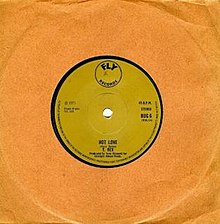Hot Love (T. Rex song)
| "Hot Love" | ||||
|---|---|---|---|---|
 Cover of the original 7" vinyl single | ||||
| Single by T. Rex | ||||
| B-side |
| |||
| Released | 12 February 1971 | |||
| Recorded | 21–22 January 1971 | |||
| Studio | Trident, London | |||
| Genre | Glam rock[1] | |||
| Length | 4:53 | |||
| Label | Fly | |||
| Songwriter(s) | Marc Bolan | |||
| Producer(s) | Tony Visconti | |||
| T. Rex singles chronology | ||||
| ||||
| Audio sample | ||||
Hot Love (excerpt) | ||||
"Hot Love" is a song by English glam rock act T. Rex, released as a standalone single on 12 February 1971 by record label Fly. It was the group's first number one placing on the UK Singles Chart, where it remained at the top for six weeks beginning on 20 March 1971.[2]
The two performances of the song in March 1971 on Top of the Pops, which saw Bolan dressed for the first time on television in shiny satin stagewear and glittery make-up (the latter at the suggestion of his stylist Chelita Secunda) were a crucial trigger for the glam rock movement.[3] In a UK poll in 2015 it was voted eleventh on the ITV special The Nation's Favourite 70s Number One.[4]
Background and recording
"Hot Love" was recorded at Trident Studios on 21 and 22 January 1971. The single's B-sides, "Woodland Rock" and "The King of the Mountain Cometh", were recorded onto the same 16 track tape.[5]
The song marks the first time a full drum kit appeared on a T. Rex song, after Bill Fifield joined the group at Tony Visconti's suggestion. The single was issued and, due to its success, Fifield was invited to audition to join the band, adopting the stage name Legend.[6]
Personnel
- Marc Bolan – lead vocals, guitar
- Howard Kaylan and Mark Volman – backing vocals
- Steve Currie – bass guitar
- Mickey Finn – handclaps
- Tony Visconti – string arrangement
- Bill Legend – drums
Release
"Hot Love" was released as a single on 12 February 1971 by record label Fly.[7] It was the group's first number one placing on the UK Singles Chart, where it remained at the top for six weeks beginning in March 1971.[2] The single, however, did not fare as well in the US, where it peaked at number 72 on the Billboard Hot 100[8] and #54 on the Cash Box Top 100.[9] The song reached number 47 in Canada in June 1971, number 4 in Australia[10] and number 12 in South Africa.[11]
References
- ^ Savage, Jon (1 February 2013). "The 20 best glam-rock songs of all time". The Guardian. Retrieved 15 May 2016.
- ^ a b Roberts 2006, p. 258–9.
- ^ Mark Paytress, Bolan - The Rise And Fall Of A 20th Century Superstar (Omnibus Press 2002) ISBN 0-7119-9293-2, pp 180-181
- ^ "The Nation's Favourite 70s Number One has been revealed, but here are some 70s classics which didn't make the cut | Metro News". metro.co.uk. Retrieved 11 August 2016.
- ^ Campbell, Irving (2007). A guide to the outtakes of Marc Bolan (1964-1977). Wellington, N.Z.: Great Horse Productions. ISBN 978-0-473-12076-4.
- ^ Paytress, Mark (2006). Bolan : the rise and fall of a 20th century superstar ([Rev.ed.]. ed.). London: Omnibus Press. ISBN 1-84609-147-0.
- ^ Roberts 2006, p. 546.
- ^ "T. Rex". Billboard. Retrieved 11 March 2018.
- ^ "Cash Box Top 100 6/12/71". tropicalglen.com. Archived from the original on 23 October 2016. Retrieved 23 October 2016.
- ^ "Forum – ARIA Charts: Special Occasion Charts – 1971". Australian-charts.com. Hung Medien. Retrieved 17 April 2020.
- ^ Currin, Brian Currin. "South African Rock Lists Website – SA Charts 1969 – 1989 Acts (T)". rock.co.za. Retrieved 16 February 2015.
- Roberts, David (2006). British Hit Singles & Albums. London, England: Guinness World Records Limited. ISBN 1-904994-10-5.
{{cite book}}: Invalid|ref=harv(help)
External links
- "Hot Love" at Discogs (list of releases)
- Template:MetroLyrics song
